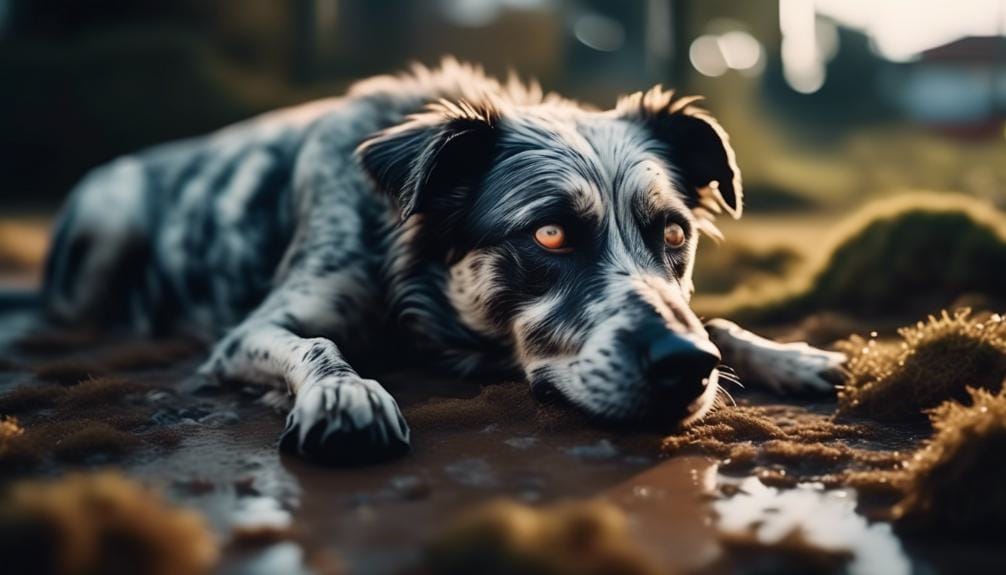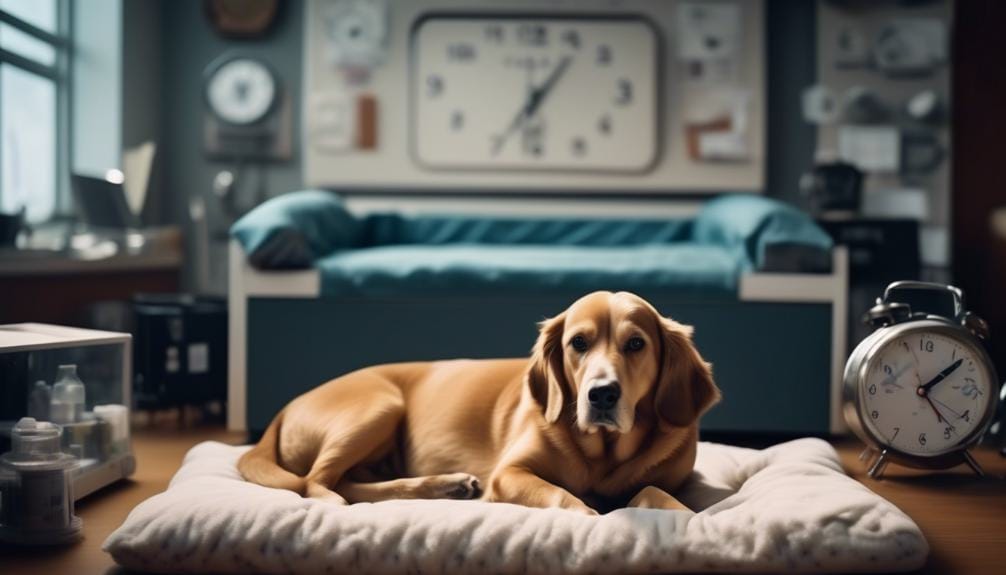You’ve just noticed that your beloved dog is lethargic, refusing to eat, and vomiting. These could be the initial signs of parvo, a highly contagious and potentially fatal virus. Understanding the timeline of how long parvo takes to kill a dog is crucial for recognizing the urgency of seeking veterinary care.
The journey from the onset of symptoms to the potential fatality of parvo is a critical one, and knowing what to expect can help you make informed decisions for your pet’s well-being. But just how long does it take for this virus to wreak its havoc?
Understanding the fatal timeline of parvo is essential for every dog owner, and it’s a topic that demands attention and understanding.
Key Takeaways
- Parvo has an incubation period of 3-7 days, but it can extend up to two to four weeks in some cases.
- Infected dogs are highly contagious, even if they have been vaccinated.
- Parvo causes severe gastrointestinal symptoms, including relentless vomiting and bloody diarrhea, and weakens the dog’s immune system.
- The disease progresses rapidly, with symptoms escalating to a life-threatening state within 24-72 hours, making prompt and intensive treatment essential for survival.
Understanding Parvo’s Incubation Period
Understanding Parvo’s incubation period is crucial for recognizing and isolating infected dogs to prevent further spread, especially considering the virus can shed for up to 10 days before symptoms appear, increasing the risk of transmission. The incubation period for canine parvovirus is typically 3-7 days, during which the virus replicates within the body, making the infected dog highly contagious. However, it’s essential to note that in some cases, this period can extend up to two to four weeks.
For puppies infected with parvo, the symptoms can be particularly severe. These may include lethargy, loss of appetite, vomiting, and severe, often bloody, diarrhea. If you suspect that your dog is infected, it’s crucial to seek veterinary attention immediately. Prompt intervention can significantly improve the chances of recovery.
Additionally, understanding the incubation period also underlines the importance of vaccination. Even vaccinated dogs can shed the virus, posing a risk to unvaccinated dogs. Therefore, ensuring that all dogs are vaccinated helps in preventing the spread of this deadly virus.
The Devastating Impact on a Dog’s Health

The devastating impact of parvo on a dog’s health becomes alarmingly evident as the virus wreaks havoc on their gastrointestinal system, leading to severe symptoms and a distressing decline in their overall well-being.
- Severe Gastrointestinal Symptoms: Parvo-infected dogs experience relentless vomiting and bloody diarrhea, causing extreme discomfort and weakness. Witnessing your beloved pet in such agony can be heart-wrenching.
- Low White Blood Cell Count: The virus attacks rapidly dividing cells, including those in the bone marrow, resulting in a decreased white blood cell count. This weakens the dog’s immune system, making them susceptible to secondary infections, intensifying their suffering.
- Long Road to Recovery: Watching your furry companion endure weeks of intensive care, including intravenous fluid therapy, and months of gastrointestinal recovery is emotionally taxing. The toll it takes on your dog’s spirit and your own is indescribable.
Witnessing the devastating impact of parvo on an infected dog’s health is overwhelmingly distressing. However, you can take action to prevent your dog from experiencing this anguish. Protect your dog by ensuring they receive timely vaccinations to shield them from this brutal form of parvo.
Unveiling the Progression of the Disease
As an owner, you need to understand how rapidly parvo progresses, with symptoms emerging 3-10 days after exposure to the parvovirus (CPV).
Once your dog is infected, the virus rapidly attacks rapidly dividing cells, particularly in the intestines and bone marrow, leading to severe gastrointestinal and immune system damage.
The progression of the disease can be alarmingly swift, with symptoms escalating to a life-threatening state within 24-72 hours.
It’s crucial to recognize that without prompt and intensive treatment at a veterinary clinic, the virus can lead to severe dehydration, septic shock, and potentially death within a week of infection.
This is especially critical for young puppies, as their immune systems are particularly vulnerable.
Parvo can lead to electrolyte imbalances and compromise heart function, further hastening the progression of the disease.
Understanding the rapid progression of parvo emphasizes the urgent need for immediate veterinary attention and supportive care.
If your dog has come in contact with infected dogs or contaminated environments, it’s imperative to seek veterinary care without delay.
Recognizing the Critical Stage of Parvo

Monitoring for signs of severe dehydration, shock, and collapse is crucial for recognizing the critical stage of parvo in dogs. This is a challenging and distressing time for both you and your beloved pet, but being aware of the following signs can help you identify when the disease has reached a critical stage:
- High heart rate, difficulty breathing, and hypothermia
- Severe weakness and a rapid decline in your dog’s condition
- Worsening of symptoms despite treatment
These signs indicate that immediate veterinary attention is essential. During the critical stage, intensive supportive care, including intravenous fluids, is crucial to increase the chances of survival. Your veterinarian will closely monitor your dog’s vital signs, hydration status, and response to treatment.
It’s important to remember that even vaccinated dogs can become infected with parvo, so being vigilant about your pet’s health and seeking prompt medical care can make all the difference. Stay strong and know that you’re not alone in this difficult time. Your commitment to your pet’s well-being is commendable, and seeking help is the best thing you can do for your furry friend.
The Fatal Outcome of Parvo Infection

Recognizing the critical stage of parvo in dogs is crucial for their well-being; unfortunately, the fatal outcome of parvo infection can be devastating if left untreated. Parvo, short for parvovirus, affects a dog’s body’s ability to absorb nutrients and liquids, leading to severe dehydration and damage to the intestines. The virus is notorious for its high mortality rate, killing up to 91% of infected dogs if not promptly addressed. When the infection progresses, it can cause severe diarrhea with blood, leading to life-threatening conditions. Immediate veterinary attention is crucial if symptoms like lethargy and vomiting are noticed. Even with aggressive treatment, the survival of infected dogs is not guaranteed. To illustrate the severity of the fatal outcome of parvo infection, the table below provides a glimpse into the devastating impact this virus can have on dogs.
| Fatal Outcome of Parvo Infection | ||
|---|---|---|
| High mortality rate if untreated | Severe dehydration and damage to intestines | Life-threatening conditions due to severe diarrhea with blood |
| Lethargy and vomiting symptoms | Immediate veterinary attention crucial | Aggressive treatment not always guarantee survival |
It is critical to understand that parvo can be a silent killer, and taking preventive measures through proper vaccination is the best way to protect dogs from this devastating fate.
Frequently Asked Questions
How Long Can a Dog Have Parvo Before It Dies?
If your dog has parvo, early detection and prompt treatment are critical. Without intervention, parvo can be fatal within a matter of days. Seek immediate veterinary care to give your dog the best chance of survival.
What Is the Final Stage of Parvo?
In the final stage of parvo, your dog experiences severe dehydration, shock, and organ failure. Without immediate treatment, death can occur within 2-3 days. Hospitalization and intensive care are crucial for survival.
What Is the Timeline of Parvo in Dogs?
Parvo in dogs progresses rapidly, with symptoms appearing 3-7 days after exposure. The virus peaks in activity and severity at 7-10 days. If your dog survives this critical period, chances of recovery significantly increase.
What Is the Critical Time for Parvo in Dogs?
During the critical time for parvo in dogs, immediate veterinary attention is crucial. If left untreated, it can be fatal within 2-3 days of symptom onset. Intravenous fluid therapy is essential to prevent dehydration and support the dog’s system.
Conclusion
In conclusion, parvo can be deadly for dogs, with some cases resulting in death within 24-48 hours of showing symptoms. It’s crucial to seek immediate veterinary care if you suspect your dog has parvo to increase their chances of survival.
With proper treatment, including fluid therapy and supportive care, the survival rate can significantly improve.
Don’t hesitate to seek help for your furry friend if you suspect they may have parvo.





Leave a Reply
You must be logged in to post a comment.